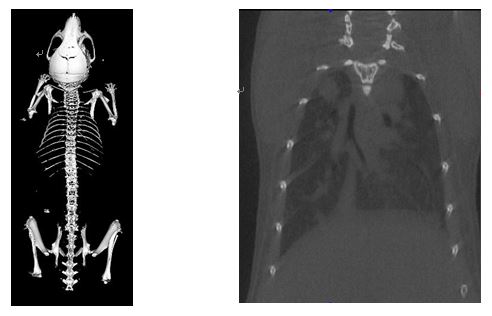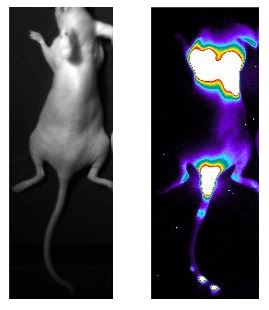Imaging Analysis
Service content: Analysis of bone density, trabecular bone and other parameters
Sample requirements: Live mice or local specimens of mice. The bone samples of mice, rabbits, and dogs should not exceed 10 cm in length.
Testing instruments: Micro-CT (eXplore Locus, GE Healthcare)
Principle: X-ray tomography and computer reconstruction are non-destructive 3D imaging techniques used to study the internal microstructure of a sample. The difference between micro-CT and conventional CT is that the resolution of micro-CT can reach the micron level.
Service cycle: Regular scan 25 min/time, whole-body in vivo scan 1 h/mouse (without tail)
Notice to customers: Do not decalcify fresh or fixed specimens used for scanning. Contrast-assisted imaging is required for tissues such as liver, blood vessels, and intestines.

Figure 1. Left panel: A screenshot of the skeletal image of an entire mouse; Right panel: Scan of lung tumor.
Principle: The luciferase reporter gene system is a reporter system that uses luciferin as a substrate to detect the activity of firefly luciferase. Luciferase can catalyze the oxidation of luciferin to produce oxyluciferin and this oxidation process emits bioluminescence. A fluorometer, also known as a luminometer or a liquid scintillation counter, can measure the bioluminescence released during the oxidation of luciferin.
Sample requirements: Fluorescently labeled mouse or tissue
Testing instruments and consumables: In vivo animal fluorescence imaging system (America/Roper Scientific), Luciferin
Service cycle: 1 business day. The service cycle of some fluorescence tracking experiments will be determined according to the experimental plan
Notice to customers: An appointment should be made at least 3 days in advance. It is recommended to collect organ or tissue samples on-site for imaging. For the in vivo imaging of mouse fluorescence, the target part should be shaved

Figure 1. In vivo imaging of live mice showing lung metastasis of luciferase-labeled tumor cells
Popular articles
SMOC’s Annual Progress and Advances in Preclinical immuno-Oncology Research: The workshop is designed as a forum for ideas and opinions exchange on how to decrease the rate of clinical failures in oncology and immuno-oncology.
Learn moreAfter the base is put into operation, SMOC’s capability to provide genetically modified rat/mouse models and technical services including gene function research and drug development will be greatly enhanced.
Learn more

